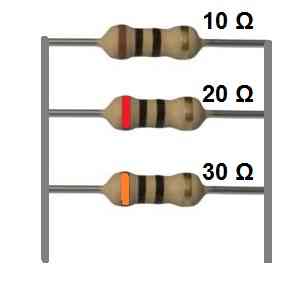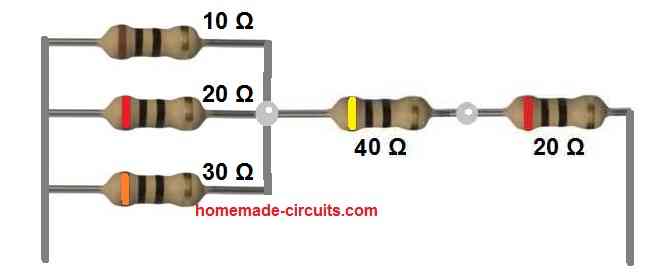There are three ways to interconnect resistors: series, parallel and in combination of series/parallel. When resistors are joined in series, the current passing via one resistor also passes through the next. When resistors are joined in parallel, they are wired across each other, resulting in the same voltage across each resistor. When resistors are connected in a combination of series and parallel, the current passage is a bit more complex.
Connecting Resistors in Series:

Assume you have three resistors with resistances of 10, 20, and 30 ohms. For a series connection:
We connect the 3 resistors one after the other as shown in the above figure.
The total series resistance can be measure across the ends of the series connection using a Ohm meter or can be calculated as I have explained below.
According to Ohm's law the total resistance of the series resistors can be calculated simply by adding the three resistor values.
R(total) = 10 + 20 + 30 = 60 ohms is the total resistance of the circuit.
Connecting Resistors in Parallel:

Let's say you have three resistors with values of 10 ohms, 20 ohms, and 30 ohms. In order to connect them in parallel, you will need to follow the below shown steps:
Connect all left side ends together, and then connect all the right side ends together, as shown in the above figure.
You can measure the parallel resistance value using an Ohm meter by connecting the ends of the resistances with the meter probe.
Alternatively, using the standard formula, the total resistance of the parallel circuit could be calculated as the reciprocal of the sum of the reciprocals of the individual resistances:
1/Rp(total) = 1/10 + 1/20 + 1/30 = 5.45 ohms.
Combination of Series and Parallel:

Now, let's assume we have four resistors with values of 10 ohms, 20 ohms, 30 ohms, and 40 ohms. To connect them in a combination of series and parallel we do the following setup
First we connect 3 resistors in parallel, meaning we connect the 10 ohm, 20 ohm and 30 ohm in parallel.
Then we connect a 40 ohm and a 20 ohm resistor in series and join this series connection with the above parallel setup.
To solve this series, parallel combination, we first solve the parallel configuration using the following formula:
1/Rp(total) = 1/10 + 1/20 + 1/30
R(total) = 5.45 ohms
Once the parallel combination is solved, then we solve the series combination using the following formula:
Rs(total) = 20 + 40 = 60 ohms.
Now, looking at the diagram it is obvious that the 5.45 ohms value of the parallel resistors is in series with the above 60 ohm resistor.
Therefore, we now simply add the 5.45 ohm with the 60 ohm to get the final result of the series, parallel combination, in the following manner:
R(total) = 5.45 + 60 = 65.45 Ohms
If you connect an ohm meter probes to the parallel end and the series end of the above combination, you will get the same value as obtained from the above calculation.
Hi Mr Swagatam;
In case we have two cables and their thickness and the length are equal but one is stranded type and other is single core. then which one is more resistant against the heat?
Hi Suat,
The standard cable which has multi-strand wire will generate less heat compared to a single core wire, so the multi-strand wire will be more efficient.
Hi Swagatam;
Let’s say we have 2 resistors of 100 Ohm and their wattage value are of 1/4 watts. When we connect them in parallel so then they would be as single resistor like with the value of 50 ohm however their wattage would be remain same as 1/4 watts or double as 1/2 watts?
Best Wishes
Hi Suat,
The wattage would become double, 1/2 watts.
thanks swagatam. We have the ordinary potentiometer at the market and i think they are called also universal hub single variable resistor. Neverthless it is not being mentioned about their wattage. For instant i have got 5K pot so please advise their wattage and if it is possible to connect them in parallel?
Best Wishes
Hi Suat, the ordinary pots are rated not more than 1/2 watt.
If you want to add them in parallel then you will have to make sure they are GANGED, meaning their wiper knobs are tied with each other so that they rotate exactly in a synchronized manner.
Hi Swagatam;
I have been seeing the videos about making your own resistor. As known sometimes hard to find cement resistor at lower ohm value like 0,1 ohm and sometimes they are very expensive. It is possible to make them at home by defining its ohm value and wattage and which material is more poductive i.e. copper graphite (pencil core) or chrome wire?
Best Wishes.
Hi Suat,
Sorry, I have no idea about this concept so not sure about it. I will have to investigate about it.
hello, good afternoon. I have a question, I have to feed a 12 vdc relay from a 31 vdc voltage. Now the question is, can I put a resistive divider instead of using a regulator for example lm7812… Thank you very much in advance.
A resistive divider might drop too much current which might not be sufficient for the relay to operate. You will have to use a 7812 IC or step down buck converter.